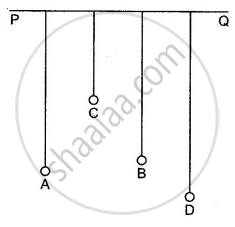Advertisements
Advertisements
प्रश्न
Describe a simple experiment to illustrate the phenomenon of resonance and explain it.
उत्तर

Four pendulums A, B, C, and D are suspended from a rubber string PQ. The pendulums A and B are of equal lengths while C is shorter and D is longer. The pendulum A is set into vibration. It is observed that the pendulum B also starts vibrating and ultimately acquires the same amplitude as that of A. The pendulums C and D also vibrate, but with smaller amplitudes. The pendulum B is said to be in resonance with pendulum A.
Explanation: The natural frequency of pendulum B is equal to the frequency of vibration of pendulum A since both are of equal lengths. So the forced vibrations caused in pendulum B are in resonance with vibrations of pendulum A. On the other hand, the natural frequency of pendulum C is higher while of D is smaller than that of pendulum A. So these pendulums vibrate with the frequency of pendulum A with smaller amplitudes due to forced vibrations.
APPEARS IN
संबंधित प्रश्न
How does the medium affect the amplitude of free/natural vibrations of a body?
What are forced vibrations?
Distinguish between the free (or natural) and forced vibrations.
Why is a loud sound heard at resonance?
Why are the stringed instruments like guitar provided with a hollow sound box?
Differentiate between the following:
Radio waves and light waves.
What do you mean by resonance? When does resonance occur?
When acoustic resonance takes place, a loud sound is heard. Why does this happen? Explain.
